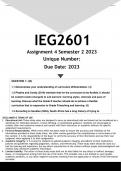IEG2601
Assignment 4 Semester 2 2023
Unique Number:
Due Date: 2023
QUESTION 1: (30)
1.1 Demonstrate your understanding of curriculum differentiation. (4)
1.2 Phasha and Condy (2016) maintain that for the curriculum to be flexible, it should
be custom-made (changed) to suit learners’ learning styles, interests and pace of
learning. Discuss what the Grade R teacher should do to achieve a flexible
curriculum that is responsive to Grade R teaching and learning. (5)
1.3 According to Soudien (2004), South Africa has a long history of trying to
accommodate the special needs of learners, to some extent. Explain what is meant
DISCLAIMER & TERMS OF USE
by, “Many
1. Educational learners
Aid: These with
study barriers
notes to learning
are designed to servehave been neglected
as educational aids andand only
should nota be
fewconsidered as a
substitute for individual research, critical
have seen their needs met.” (5) thinking, or professional guidance. Students are encouraged to
conduct their own extensive research and consult with their instructors or academic advisors for specific
assignment requirements.
2. Personal Responsibility: While every effort has been made to ensure the accuracy and reliability of the
information provided in these study notes, the seller cannot guarantee the completeness or correctness of all
the content. It is the responsibility of the buyer to verify the accuracy of the information and use their own
judgment when applying it to their assignments.
3. Academic Integrity: It is crucial for students to uphold academic integrity and adhere to their institution's
policies and guidelines regarding plagiarism, citation, and referencing. These study notes should be used as a
tool for learning and inspiration, but any direct reproduction of the content without proper acknowledgment and
citation may constitute academic misconduct.
4. Limited Liability: The seller of these study notes shall not be held liable for any direct or indirect damages,
losses, or consequences arising from the use of the notes. This includes, but is not limited to, poor grades,
academic penalties, or any other negative outcomes resulting from the application or misuse of the information
provided.
, For additional support +27 81 278 3372
1.1 Curriculum differentiation is the process of modifying and adapting the curriculum
to meet the diverse needs and abilities of students. It involves tailoring the content,
learning activities, and assessment methods to accommodate individual learning
styles, interests, and readiness levels. This approach recognizes that students have
diverse learning profiles and ensures that all students can access and engage with the
curriculum effectively.
1.2 To achieve a flexible curriculum that is responsive to Grade R teaching and
learning, the Grade R teacher should consider the following:
Understand and assess learners' learning styles: The teacher should strive to
understand the different ways in which students learn best. This can be achieved
through formal and informal assessments, allowing the teacher to identify students'
learning preferences and tailor instruction accordingly.
Incorporate students' interests: The teacher should make an effort to incorporate
students' interests and passions within the curriculum. This can be done by allowing
students to choose topics or activities, integrating real-world applications, and using
relevant examples.
Provide a variety of learning experiences: The teacher should design learning
experiences that cater to different learning preferences and pace of learning. This can
include incorporating visual, auditory, and kinesthetic activities, providing opportunities
for group work, and allowing for independent study.
Differentiate instruction and assessment: The teacher should adapt instruction and
assessment methods to meet the needs of diverse learners. This can involve providing
additional support or challenge, using different materials or resources, and offering
alternative assessments.
By implementing these strategies, the Grade R teacher can create a flexible curriculum
that addresses the individual needs of learners and promotes successful teaching and
learning.




